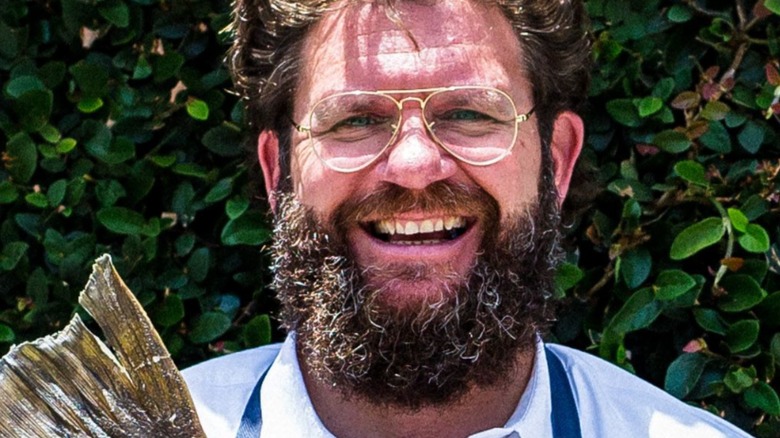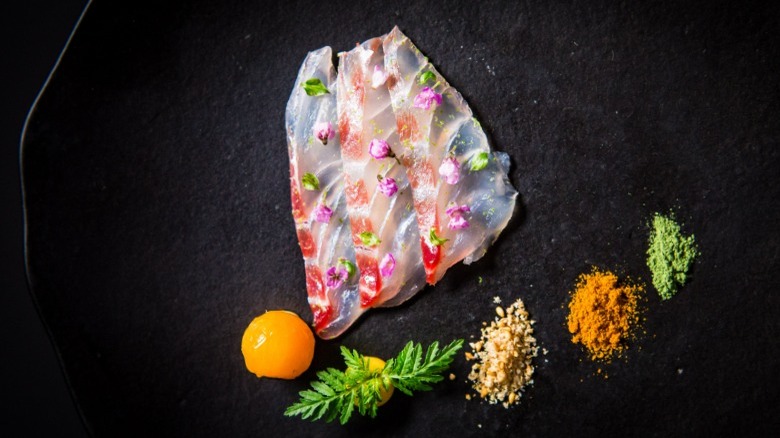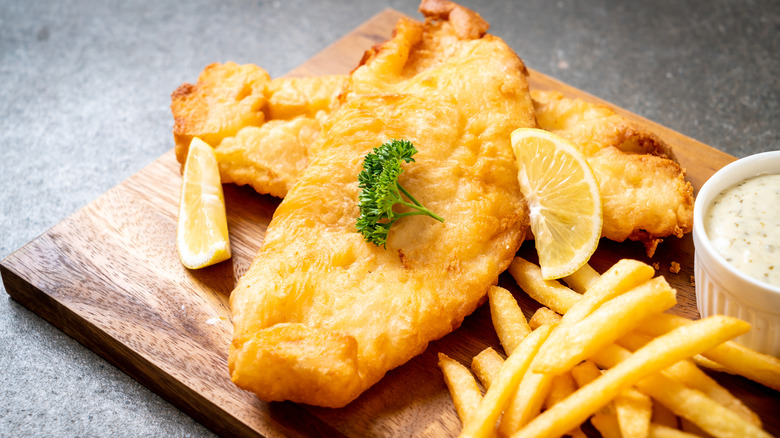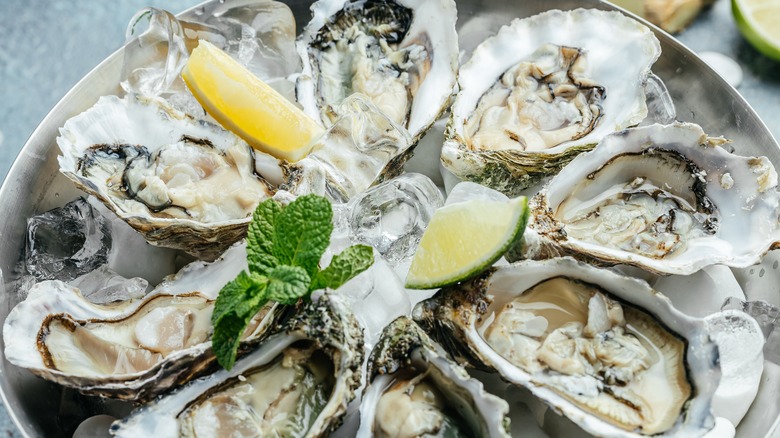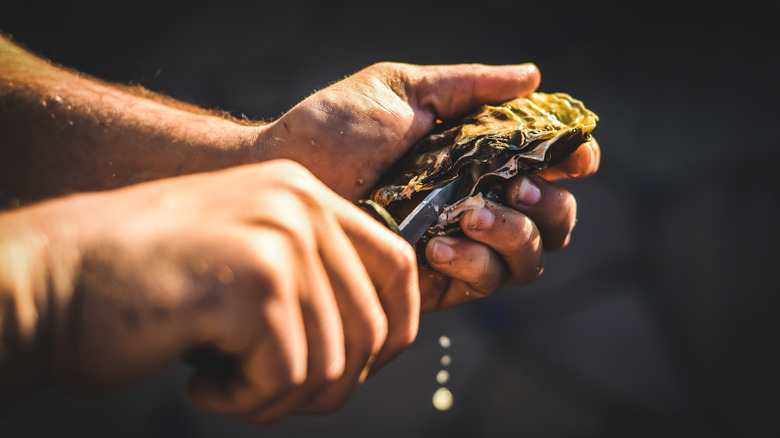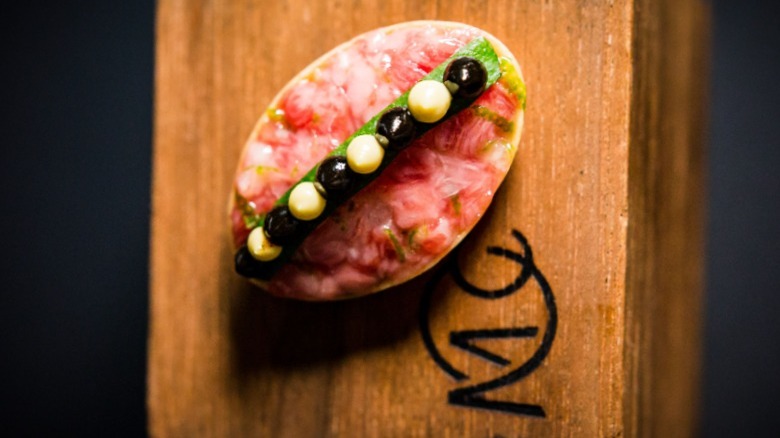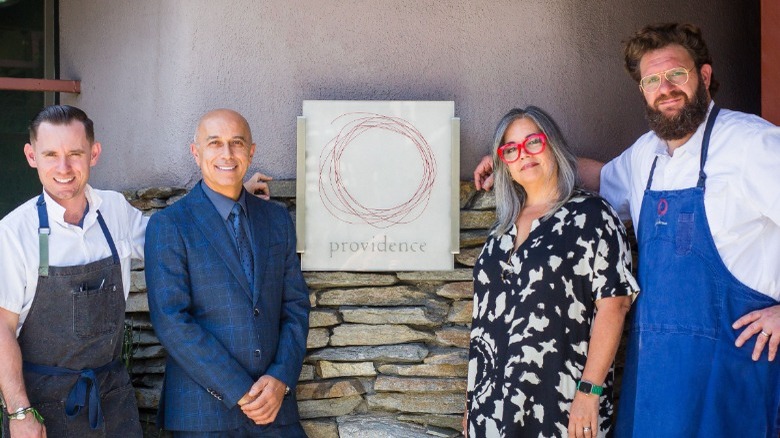Chef Michael Cimarusti Celebrates 17 Years Of Sustainable Seafood At Providence LA - Exclusive Interview
Providence LA is one of the most celebrated and resilient fine-dining destinations in Los Angeles. Thanks to Chef Michael Cimarusti's passion for quality seafood and sustainable practices, Providence has survived economic downturns, an ever-changing climate, and a pandemic. Though Providence LA focuses on seafood, this innovative fine-dining destination also offers a vegetarian tasting menu for those that follow a plant-based diet.
From the rooftop garden to the thoughtful practices around local sourcing, Chef Michael Cimarusti and Providence LA go above and beyond to create a quality dining experience that is rooted in consciousness. Though there are many fine-dining spots in Los Angeles, Providence stands out from the competition thanks to its unwavering commitment to care, consideration, and the art of cuisine. During an exclusive interview with Tasting Table, Chef Cimarusti discussed everything from sustainability at the restaurant to shucking the perfect oyster at home. He even shared some of his tastiest tips and tricks.
Sustainability and seafood
Providence LA just celebrated its 17th anniversary. How does it feel to celebrate that milestone in a city that has such high turnover for restaurants and businesses?
I don't know. More than anything else, it's gratifying. It's a testament to the team that we've built here in the front of the house and in the kitchen. It's also due to the fact that we keep trying to reinvent ourselves slowly and gradually, and we try not to let things get stale. [We're] always changing, always evolving, and I still believe — and my partners do too — that our best work is in front of us.
Has remaining a sustainable seafood destination become more difficult to maintain over the years?
Absolutely. The world keeps changing, and 17 years ago when we first started this, climate change was a concern — but now we're starting to see the real-time effects of climate change and how they affect fisheries and how they affect our oceans. A sustainable fishery [is] an important thing, but the overarching effects that climate change has on our environment are starting to complicate things even further.
I know that you try to avoid using bluefin tuna. Are there any other practices that you can share that you do to keep everything as sustainable as possible?
We always try to do our best to stay local whenever possible, to do business with people that we have good, strong relationships with — people that supply us with fish that's sustainable. We try to fill a menu that is entirely sustainable, and we don't use any farm-raised fish. We do use lots of farm-raised, zero-input shellfish, like mussels and clams and oysters and things like that. But when it comes to fish, it's only wild.
That's becoming more and more difficult as well, but [it's] something that we're committed to. When there are things that we'd like to have for the menu but we can't find them from wild fisheries, we move on to something else. That's the best way for us to try to continue to achieve those goals of being as sustainable as we can.
What is a fish that you recommend buying if you're trying to cook sustainable seafood at home?
That's a tough question to ask, and the answer to it depends upon where you live. Here in Southern California, a fish that I'd be looking for here would be ... During king salmon season here in California, I'd be looking for that. When we're not in salmon season, I'd be looking for things like rockfish. There's many different species of California rockfish, but they're all pretty much sustainable and delicious, so I'd be looking for that. I'd also be looking for black cod from California. It's another amazing fish that we have here that's sustainable and abundant and pretty readily available.
Top tips for fish and chips
Connie and Ted's is famous for its fish and chips. Why is cod the chosen fish for that dish? Do you have any general fish and chips tips you can share?
We use wild Alaskan cod for that. We choose it because it's abundant and sustainable and readily available to us.
When it comes to fish and chips, the best advice that I can give you when making it is to choose a good batter — something that works, something that you like. Then there are a couple of tips that I'd give you. Number one — put the flour in the freezer before you make the batter and leave it in the freezer overnight, and make your batter the next day. The other thing that I'd recommend is to replace a certain percentage — and it's up to you how much you want to use — but replace a certain percentage of the water that's in the recipe with vodka ... Both of those two tips will help you achieve a crispier batter.
The vodka works because vodka is usually at least 40% alcohol. As soon as the batter begins to warm up, that all evaporates away. Yes, you've added more liquid to the batter, but as soon as that batter gets hot, all that vodka evaporates away, so you've got less water in the batter. That makes for a crispier coating on the fish.
The freezing thing also [is] sort of the same thing. You freeze the flour before you make the batter, and you use the batter while it's super cold. That extreme contrast between a very, very cold batter and very, very hot oil makes for a crispier result.
Do you have any tips for making tartar sauce at home, or are there any additions to that sauce that you think are a must?
Not really ... At Connie's, we make all our own pickles. We use homemade pickles when we make the tartar sauce. Making your own mayonnaise is ... Those are the two tips that I'd give you.
If you're going to make tartar sauce, most people will reach for store-bought mayo, which is fine. I have store-bought mayonnaise in my fridge at home too. But when you make something like tartar sauce, if you make your own mayo, you'll get better results because you can control the flavor from the start to finish.
Preparing perfect oysters
What are your thoughts on enjoying oysters at home? Do you have any tips for shucking oysters to get a clean and shell-free experience?
First of all, the most important thing about oysters is buying oysters. It's one of the few shellfish that we eat live. You shuck them, and for the first four or five minutes after you've done that, they're still alive. You got to buy oysters that are the highest quality that you can find, the freshest that you can possibly find. Always ask, when you go to buy oysters in a fish market, to look at the tag, because shellfish in this country is very heavily regulated. All the harvest areas are heavily regulated, and the water is tested for quality and purity that the oysters are raised in.
If you are an oyster wholesaler or an oyster farmer, before you send those oysters to a retail location or a restaurant, you have to provide them with a tag that says where the oysters were harvested, the date that they were harvested, and the date that they were shipped. Generally, as a rule of thumb, you want to take a look at those tags, and you wouldn't want to buy oysters that were more than four — at the most, maybe five — days out of the water. That would be the most important tip that I could give you when you're shopping for oysters.
When you get them home, the three most important things are that they're clean, they're cold, and they're cut from the shell once you shuck them. My recommendation is to fill a sink with cold water and ice, then throw the oysters into the sink and use a wooden spoon or a rolling pin or something like that and move the oysters around in the icy water — that will help clean them. It will remove sand and dirt that might be on the shell and will also chill them down.
Then, remove the oysters from the ice water and put them on a tray, cup side down. Oysters always have a rounded side, which is a side that is sitting on the bottom of the ocean or in the bottom of the bag when they're farm-raised. Then they have a flat side, which is the top side. You always want to have the oysters right side up when you store them. Keep them in your fridge cold and preferably under a damp newspaper or a damp grocery bag, like a paper grocery bag, and store them in the fridge that way until you're ready to shuck them.
Tips for shucking oysters
Michael Cimarusti (continued): When you're ready to shuck them, you want to use a good sturdy oyster knife. Start at the mantle, and gently wiggle the knife back and forth until you break the mantle and you're able to get into the shell of the oyster. The most important tip to remember when it comes to shucking oysters is that it's not a feat of strength to get an oyster open, and you shouldn't think that you're in a fight with the oyster. You got to relax. You got to chill, and you have to find the right spot to put the knife in and gently wiggle it until the shells break at the mantle, and then you're in.
If you do it right, you shouldn't worry too much about getting shells in the oyster. If you're not using a ton of strength, you won't chip the shell too much. If you do, once you get the oyster open and cut it from the shell on the bottom, visually [look at] the oyster very, very carefully before you serve it. That's the only way that you can assure that they're going to be free of shell.
Working with luxury seafood
What is your favorite luxury seafood ingredient to work with?
I love caviar. It's a magical ingredient. It's one of those things that's a link to our past ... It became such a craze and such a delicacy once people found out about it. This country used to produce tons and tons of caviar — literally barrels full of caviar — that used to come out of our Eastern rivers and our rivers over here on the West Coast as well. They'd barrel it up and ship it over to Russia, and then the Russians would put their own stamp on it and send it back to us. It was crazy.
It's a magical ingredient, and it's absolutely one of my favorites. I understand it's a luxury item and it's out of reach for many people, but it's the kind of thing you only need a very little bit in order to enjoy it. I feel like that's the best way to enjoy it anyway, because if you're eating caviar all the time, it's not special anymore.
Connie and Ted's has a very popular lobster roll. Do you have any secret tips that you can share for making the perfect lobster roll at home?
First of all, you have to find the right bread, and that's a hard thing to do. You got to have split top buns — that's the traditional bread for a lobster roll. But with lobster rolls ... It's utterly complicated. We have two on the menu. We have one that's warmed and salted butter, and we have another one that's made the more traditional way with mayonnaise and not much else. Because there's nothing there — it's just lobster and one or two ingredients — it's got to be perfectly fresh.
That's the key to any good lobster roll. Buy good, fresh, lively lobsters, cook them properly, and serve them right away. That's what it's all about.
Foraging and fall
You've got a vegetarian tasting menu at Providence. Do you have a favorite seafood swap for vegetarians?
My favorite courses on the vegetarian menu ... are usually the wild mushroom courses. They change during the seasons. Right now, we have a vegetarian course on the menu with chanterelle, and we have another one, matsutake ... Wild food, like wild fish, [is] intriguing and wonderful.
Again, it's because it's a link to our past. There was a time when all of our ancestors went out foraging for wild foods, whether they were mushrooms or greens or wild fish or wild game. That's where our food used to come from before we domesticated it. The fact that there's still wild fish out there, and there's wild game and things like wild mushrooms — it's the link to our collective past. They're very, very special ingredients for that reason.
Do you have any exciting dishes on the fall menu at Providence that you can tell us about?
We just changed our beef course, which is one of the main course choices you have. We're a seafood restaurant, but we offer beef as the main course if you want it. It involves matsutake mushrooms, habanada peppers, which are pickled and fermented here in the restaurant, and pumpkin ... Habanadas are an ingredient that come on right at the end of summer and on the cusp of fall. Matsutake, the same thing — [it's] a beautiful wild mushroom from the Pacific Northwest and sometimes also from California. Then pumpkin ... it seems funny here in California to start thinking about pumpkin when it's a hundred degrees outside.
The truth is, now is the time when the pumpkin harvest begins, so we're doing this dish with this beautiful Musquee de Provence pumpkin — which is one of my favorite fall pumpkins — and wild matsutake, and fermented habanadas that we grow in our garden. It's delicious. It's a wonderful combination of those three things.
Do you plan on opening a new restaurant in LA anytime soon?
As of right now, I can't say, but we're always looking around. If the right opportunity presents itself, absolutely. I do have an idea in mind of what I want to do next, but we haven't quite found the right spot yet. We're working on it.
Providence LA is open for dining Tuesday through Saturday.
This interview was edited for clarity.
